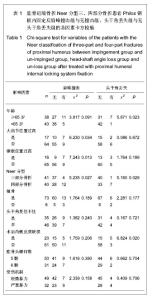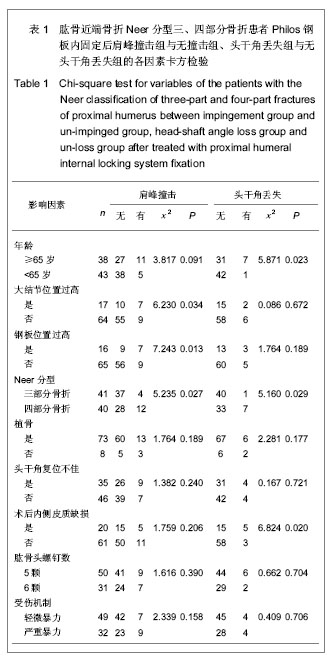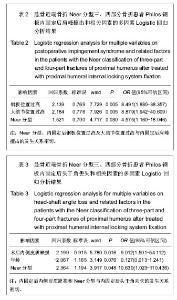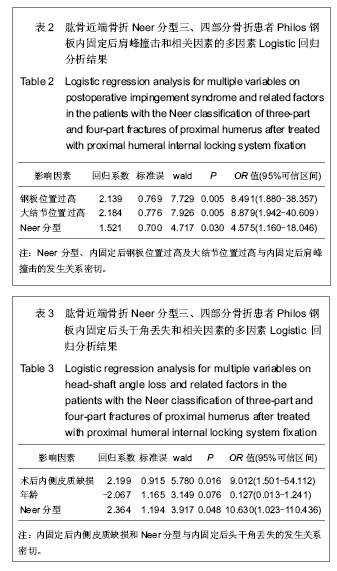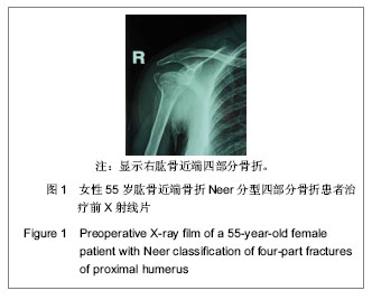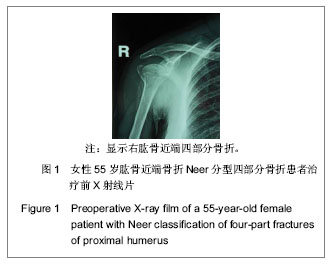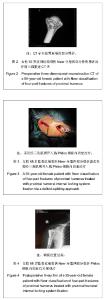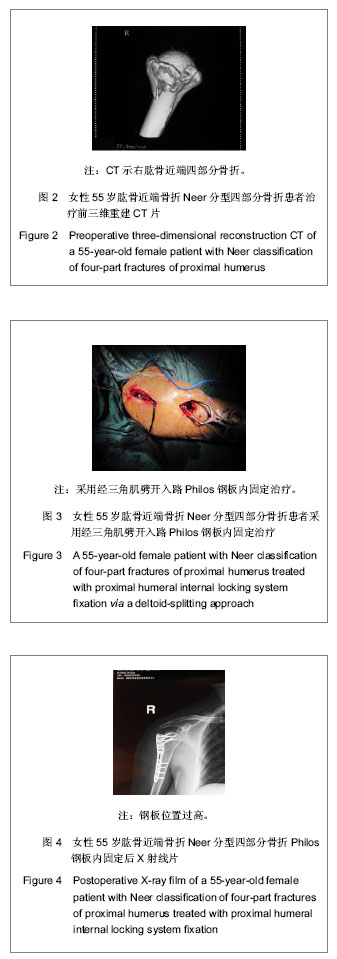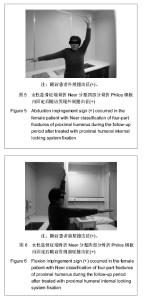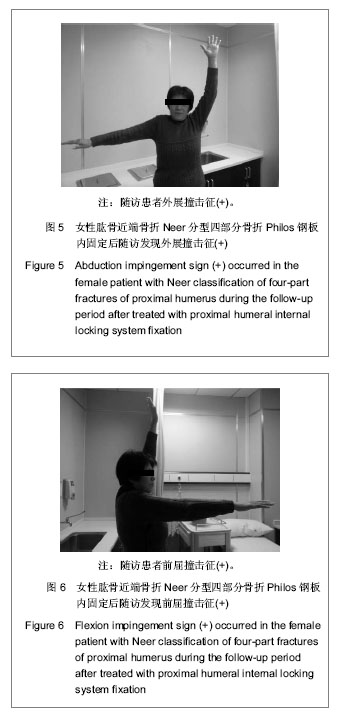| [1] Palvanen M, Kannus P, Niemi S, et al. Update in the epidemiology of proximal humeral fractures. Clin Orthop Relat Res. 2006;442:87-92.
[2] Neer CS 2nd. Displaced proximal humeral fractures. I. Classification and evaluation. J Bone Joint Surg Am. 1970; 52(6):1077-1089.
[3] 李世明,党耕町.临床骨科学[M].天津:天津科学技术出版社,1998: 295.
[4] Hardeman F, Bollars P, Donnelly M, et al. Predictive factors for functional outcome and failure in angular stable osteosynthesis of the proximal humerus. Injury. 2012;43(2): 153-158.
[5] Maier D, Jäger M, Strohm PC,et al. Treatment of proximal humeral fractures - a review of current concepts enlightened by basic principles. Acta Chir Orthop Traumatol Cech. 2012; 79(4):307-316.
[6] 马广山.老年肱骨近端粉碎性骨折的治疗进展[J].实用骨科杂志, 2012,18(5):424-426
[7] Den Hartog D, Van Lieshout EM, Tuinebreijer WE, et al. Primary hemiarthroplasty versus conservative treatment for comminuted fractures of the proximal humerus in the elderly (ProCon): a multicenter randomized controlled trial. BMC Musculoskelet Disord. 2010;11:97.
[8] 赵吉鹏,胡万坤,张秋林,等.有限切开经三角肌入路肱骨近端锁定接骨板治疗肱骨近端骨折[J],中国骨伤,2012,25(2):155-157.
[9] Gavaskar AS, Chowdary N, Abraham S. Complex proximal humerus fractures treated with locked plating utilizing an extended deltoid split approach with a shoulder strap incision. J Orthop Trauma. 2013;27(2):73-76.
[10] 韦盛旺,赵友明,杨杰,等.锁定钢板治疗肱骨近端骨折术后并发症的相关因素分析[J]. 中国骨与关节损伤杂志,2012, 27(1): 15-17.
[11] Agudelo J, Schurmann M, Stahel P, et al. Analysis of efficacy and failure in proximal humerus fractures treated with locking plates. J Orthop Trauma. 2007;21(10):676-681.
[12] 王皓,姜新. 锁定钢板加植骨治疗pilon骨折(胫骨远端骨折)的生物力学研究分析[J]. 中国医药指南,2012,10(18):117-118.
[13] 赵大海,谭平先,周国新,等. 肩峰下劈三角肌扩展人路钢板内固定治疗肱骨近端骨折[J]. 中国骨与关节损伤杂志,2013,28(5): 418-420.
[14] 卓乃强,万永鲜,鲁晓波. 锁定钢板和普通钢板置入老年复杂肱骨髁间骨折的生物力学比较[J].中国组织工程研究与临床康复, 2012,16(4):618-621.
[15] 叶庭均,王蕾.肱骨近端骨折切开复位内固定术后撞击征原因分析[J]. 国际骨科学杂志,2012,33(1):3-5.
[16] Schliemann B, Siemoneit J, Theisen CH, et al. Complex fractures of the proximal humerus in the elderly--outcome and complications after locking plate fixation. Musculoskelet Surg. 2012;96 Suppl 1:S3-11.
[17] Ring D.Current concepts in plate and screw fixation of osteoporotic proximal humeral fractues. Injury. 2007;38 (suppl 3):S59-S68.
[18] Boileau P,Krishnan S,Tinsi L,et al.Tuberosity malposition and migration:reasons for poor outcome after hemiarthroplasty for displaced fractures of the proximal humerus.J Shoulder Elbow Surg. 2002;11(5):401-412.
[19] Park TS,Choi IY,Kim YH,et al.A new suggestion for the treatment of minially displaced fractures of the proximal humerus.Bull Hosp Jt Dis.1997;56(3):171-179.
[20] Pearl ML. Proximal humeral anatomy in shoulder arthroplasty: Implications for prosthetic design and surgical technique. J Shoulder Elbow Surg. 2005;14(1 Suppl S):99S-104S.
[21] Hromádka R, Pokorný D, Popelka S, et al. Three-dimensional geometry of the proximal humerus and rotator cuff attachment and its utilization in shoulder arthroplasty. Acta Chir Orthop Traumatol Cech. 2006;73(2):77-84.
[22] Clavert P,Adam P,Bevort A,et al.Pitfalls and complications with locking plate for proximal humerus fracture.J Shoulder Elbow Surg.2010;19(4):489-494.
[23] Thanasas C, Kontakis G, Angoules A, et al.Treatment of proximal humerus fractures with locking plates: a systematic review. J Shoulder Elbow Surg. 2009;18(6):837-844.
[24] Zhang L, Zheng J, Wang W, et al.The clinical benefit of medial support screws in locking plating of proximal humerus fractures: a prospective randomized study. Int Orthop.2011; 35(11): 1655-1561.
[25] Osterhoff G,Baumgartner D, Favre P, et al. Medial support by fibula bone graft in angular stable plate fixation of proximal humeral fractures: an in vitro study with synthetic bone. J Shoulder Elbow Surg. 2011;20(5):740-746.
[26] Owsley K, Gorczyca J. Fracture displacement and screw cutout after open reduction and locked plate fixation of proximal humeral fractures. J Bone Joint Surg Am. 2008; 90(2):233-240.
[27] Sproul RC, Iyengar JJ, Devcic Z,et al. A systematic review of locking plate fixation of proximal humerus fractures. Injury. 2011;42(4):408-413.
[28] Solberg BD, Moon CN, Franco DP, et al. Surgical treatment of three and four-part proximal humeral fractures. J Bone Joint Surg Am. 2009;91(7):1689-1697.
[29] Südkamp N, Bayer J, Hepp P,et al.Open reduction and internal fixation of proximal humeral fractures with use of the locking proximal humerus plate.J Bone Joint Surg Am. 2009; 91(6):1320-1328.
[30] 王剑锋,宋海波,顾豪杰,等.微创钢板接骨术治疗老年肱骨近端骨折的病例对照研究[J].中国骨伤,2012,25(6):487-489.
[31] Khan LA, Robinson CM, Will E,et al. Assessment of axillary nerve function and functional outcome after fixation of complex proximal humeral fractures using the extended deltoid-splitting approach. Injury. 2009;40(2):181-185.
[32] Gardner MJ, Griffith MH, Dines JS,et al. The extended anterolateral acromial approach allows minimally invasive access to the proximal humerus. Clin Orthop. 2005;(434): 123-129.
[33] 刘杰,李少华,李振华,等.经皮微创新型锁定钢板治疗老年肱骨近端骨折的病例对照研究[J].中国骨伤,2013,26(1):4-8.
[34] 李昌坤,张斌,杨先武,等. 肱骨近端锁定钢板治疗肱骨近端粉碎性骨折的短期随访研究[J].四川医学,2012,33(1):98-100. |
